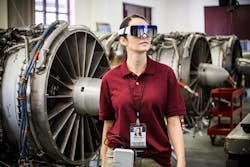It was two years ago that Google took its current version of Google Glass off store shelves, discontinuing sales and moving R&D from the Google X lab into a product development group. It might’ve been the end of Google Glass as we knew it, but it was hardly the end of heads-up display development. Just the opposite: It seemed to signal the burgeoning development of wearable augmented reality (AR) in manufacturing and other industries.
Just a few examples of late: At its latest Minds + Machines event, GE advocated the use of the Microsoft HoloLens or other heads-up display as a hands-free way for operators and technicians to interact with their environment. At multiple tradeshows this past fall, Beckhoff Automation demonstrated an advanced augmented reality proof of concept with the HoloLens connected to its Internet of Things (IoT) demos. Bosch Rexroth rolled out a support program last year using augmented reality software and smart glasses from XMReality.
Another example came out of CES 2017 earlier this month in Las Vegas, where augmented reality company Daqri released its Smart Glasses. Following on with the technology from the Daqri Smart Helmet—which was designed to protect and provide AR work instructions in industrial environments—the Daqri Smart Glasses are a streamlined form factor that the company is aiming at expanded applications, from the industrial plant into the control room as well.
The Daqri Smart Helmet provides 4D work instructions, data visualization, thermal vision and remote expert capabilities for improved situational awareness and a safer, hands-free work environment. The Daqri Smart Glasses provide similar functionality as the helmet, but in a smaller, lighter product.
The glasses’ multimedia and AR applications run on a sixth-generation Intel Core m7 processor. The wearer’s movements are tracked with a wide-angle AR tracking camera and its own AR-optimized processor. An array of sensors, including the Intel RealSense LR200 depth sensor, enables the glasses to be environment-aware, inferring depth and intuitively visualizing the workplace.
Data visualization uses distributed information and situational awareness to improve efficiency while reducing the amount of movement required in a centralized location. The glasses access and assign intuitive AR instructions on the job, displayed in an operator’s field of view, relating relevant project data to help complete tasks. The camera also allows experts to remotely assist workers by enabling them to see their colleague’s point of view and elevate their skill level.
Daqri is looking to cash in on a smart glasses market that Forrest Research expects to expand from $6 million today to more than $3.6 billion by 2025, with smart glasses in the hands of more than 14.4 million U.S. workers. Founded in 2010, Daqri has been gaining more AR expertise through several acquisitions over the past couple years, including Melon, an EEG-tracking headband company; ARToolworks, which makes the popular open-source ARToolKit libraries; 1066 Labs, a head-mounted display manufacturer; and Two Trees Photonics, which develops dynamic holographic displays for vehicles.
About the Author
Aaron Hand
Editor-in-Chief, ProFood World

Leaders relevant to this article:
